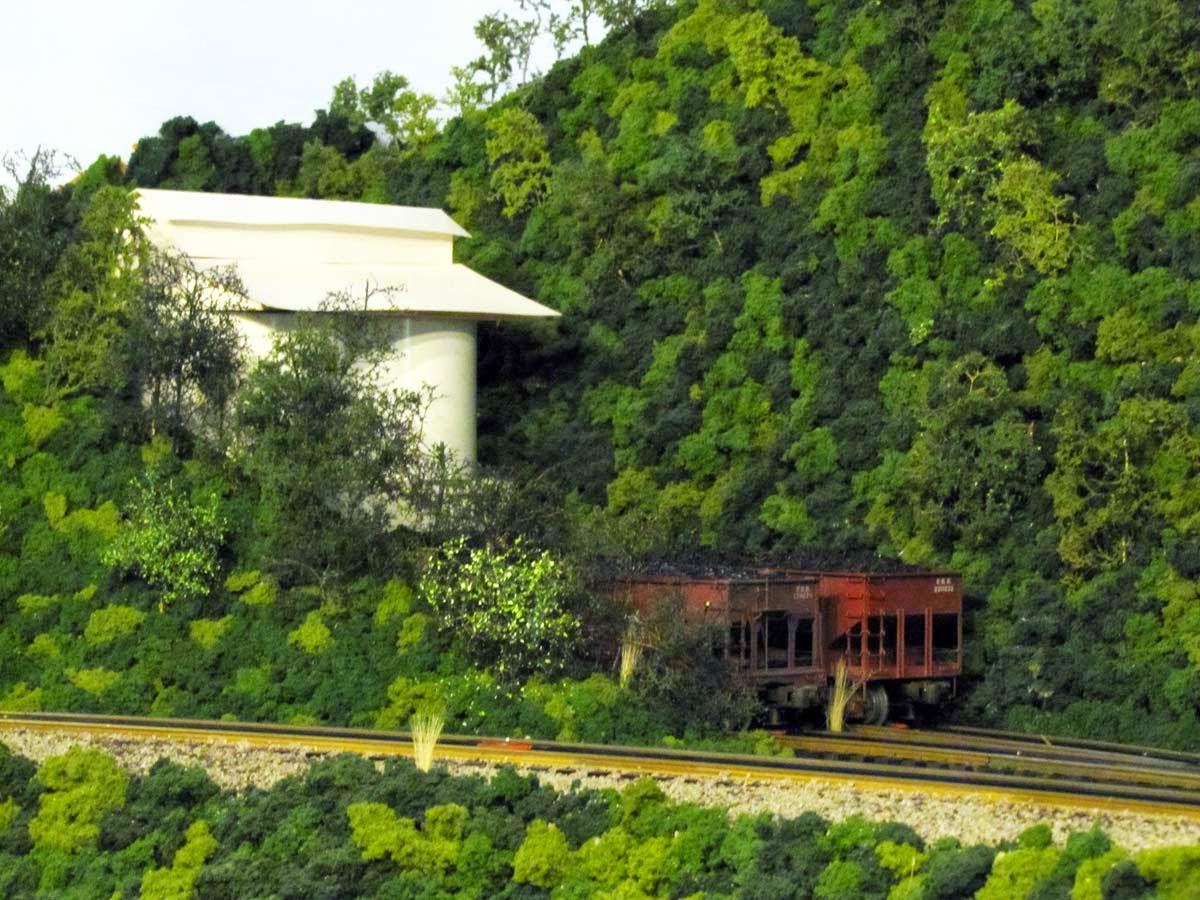In this "before" photo, we see a long curved hillside above and behind the signal bridge that will be the home of the new loader.
Here's another "before" photo showing the hillside and the tunnel that leads into Pittsburgh staging. I've never been happy with this tunnel since the light in the staging room is very visible, as is the cut wallboard that forms the tunnel. The original plan for the new loader was to move the hillside back toward the corner of the room a few inches and lay a new spur to the right of the mainline that could hold 2 or 3 hoppers. As you'll see, that's not what I wound up doing.
Here is the corner of the room after I removed most of the existing hillside. The hardshell is Bragdon Enterprises "Geodesic Foam Scenery" using nylon window screen and a 2-part resin. This material is easy to cut with a serrated kitchen knife or a utility knife.
Hmmm, it looks like if I go back into the hillside a little, I can squeeze in 2 tracks...
What's more, if I curve the tracks a little, cut a hole through the backdrop so the tracks can go all the way to the concrete basement wall...
(Note that the roadbed extension that goes through the backdrop has masonite sides and a sturdy plywood bumper padded with foam rubber.)
Each track will hold four 55-ton or three 70-ton hoppers. Note that I've re-installed part of the old hillside in the left of the photo.
A new skinny ridge was planned to hide most of the loader structure and especially the hole in the backdrop. Here is a pink styrofoam mockup of the ridge.
The ridge is now fleshed out and covered with brown wrapping paper secured with hot glue.
After adding foliage to the new ridge, it was time to re-use the rest of the old hillside that was cut out. Here it is being test fit into place. Note the bar clamp on the top to clip it to the hardshell above the tunnel portal.
After patching the foliage and adding some Supertrees to the top edge, the new/old hillside looks like it's been there forever.
The cardstock and plastic drain pipe coal loader mockup already looks pretty good! The tall yellow grass tufts show the location of electromagnetic uncouplers that are used when switching.
Here is another "through the trees" view of the loader mockup.
The tunnel into Pittsburgh now has a stone liner (stone embossed paper glued to 1/8" hardboard and given a heavy black wash). The tunnel interior is pretty dark due to a shading structure that I built on the other side of the wall.
Here is the shading structure in the staging room (masonite sides and roof). Please excuse the piece of cardboard in the front, I temporarily ran out of masonite.
The new coal loader area has two Tortoise switch machines and three electromagnetic uncouplers, so a small control panel was built. The new panel is just to the right of the Pittsburgh/Conway Yard/Shire Oaks panel.
The panel includes LED indication showing which track is aligned. Green indicates the main line is selected, red means one of the loader sidings is active.
Finally, here are a couple of Before and After shots. The look of the hillside was maintained even though a new structure and 7 or 8 switching spots were added. I didn't want the new loader to distract attention away from the Railway Express building in this scene.
The appearance of the tunnel into Pittsburgh has improved greatly as well.
Remaining tasks here are to add some ballast, just a little more ground cover and build the permanent loader. Fortunately, a friend has volunteered to build the structure. :-)





















Now that's what I call a shoe-horn! But what a nice opportunity to add switching spots and a very appropriate Appalachian industry, and a good reason to get around to solving the tunnel light problem. Thanks for the step-by-step blog post.
ReplyDelete